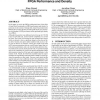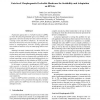862 search results - page 59 / 173 » The amorphous FPGA architecture |
FPL
2008
Springer
14 years 11 months ago
2008
Springer
Exploiting the underutilisation of variable-length DSP algorithms during normal operation is vital, when seeking to maximise the achievable functionality of an application within ...
ARC
2011
Springer
14 years 1 months ago
2011
Springer
Increasing transmission speeds in high-performance networks pose significant challenges to protecting the systems and networking infrastructure. Reconfigurable devices have alrea...
FPGA
2000
ACM
15 years 1 months ago
2000
ACM
In this paper we revisit the FPGA architectural issue of the effect of logic block functionality on FPGA performance and density. In particular, in the context of lookup table, cl...
AHS
2006
IEEE
15 years 3 months ago
2006
IEEE
Traditional approaches to evolvable hardware (EHW), in which the field programmable gate array (FPGA) configuration is directly encoded, have not scaled well with increasing cir...
SLIP
2006
ACM
15 years 3 months ago
2006
ACM
A fundamental difference between ASICs and FPGAs is that wires in ASICs are designed such that it matches the requirements of a particular design. Wire parameters such as: length...


